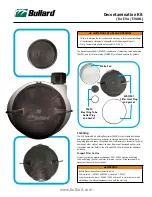
5.1.
Compressed air hose for respiratory protection devices
5.2.
Donning the helmet
Do not don (put on) the helmet before correct functioning has been achieved.
To guarantee secure protection this helmet must fit property or be adjusted to the size of the user’s head. The head support can be adjusted for this purpose
using an adjustable band. The head support must be set in such a way that it fits securely on the head in order to avoid undesirable helmet movement. The
wearing height of the helmet can be adjusted using the banding on the helmet. Check the elastic soft collar – it needs to sit close to the neck all the way
around like a roll-neck sweater. Both the body protection and the belt must fit correctly, as described in point 5.
5.3
Warning device
The warning device notifies the user if the helmet is not being supplied with sufficient breathing air. If the pointer of warning device drops below 3,0 bar (44
psi) during use then the user must immediately leave the blast-cleaning area, remove the helmet and check the air supply. Possible causes could be e.g.
pinching of the hose, a tear in the compressed air hose for breathing air or a malfunction in the compressor.
6.
Utilization
Do not don (put on) the helmet before correct functioning has been achieved.
The area with contaminated atmosphere can be entered once the helmet is functioning correctly and has been donned. The user must read and understand
all functional information. Use the Respiratory protective devices with this information brochure, the relevant valid statutory regulations and the safety
requirements of the profession associations, particularly the regulations for use in accordance with DGUV Rule 112-190 resp. DIN EN 529 ‘Respiratory
protective devices – recommendation for selection, use, care and maintenance – guidelines’.
For safety reasons this hazard area must be vacated immediately if there is any sign of a malfunction in the helmet, e.g. a warning from the warning device
(see 5.3), an increase in breathing resistance or awareness of the contaminant (through smell, burning eyes etc.) or an adverse effect to the condition of the
person wearing the device.
7.
Repair, cleaning and disinfection
The helmet must be repaired, cleaned and disinfected in accordance with the fact sheet on respiratory protection from the main association of commercial
associations (DGUV Rule 112-190) in line with the following table of time limits.
* or reserve equipment
7.1.
Exchanging lenses
The window frame on the tension lock must be opened when exchanging the inner lens C4. The inner lens that needs to be replaced must be removed
carefully from the window profile seal. Then remove the protective foils on the new inner lens. This inner lens is now inserted by fist sliding the two lower
ends into the window profile seal first and then sliding in the lower edge. The upper edge of the window profile seal must now be lifted and the side
sections and the upper edge inserted. Finally release the window profile seal and push flat (tip: lubricate the groove on the window profile seal with liquid
soap). Last of all close the window frame again. The inner lens C4 is conforms to EN 14594:2005 Section 6.16.2.2.
7.2.
Checking and testing function
This must be carried out before the initial release of the helmet for use and before each use, every time parts are replaced, every six months and as
described above.
Inner-Ø
Mm
9,5
Wall thickness
Mm
4,5
Operating pressure*
bar/psi
10/145
Minimum Burst pressure*
bar/psi
≥ 40/580
Smallest bending radius
ca. mm
50
Weight per metre
ca. g/m
280
Time limits
Type of work to be carried out
Before release for use
Before use
After use
Semi-annually
Annually
Function tests
X
X
X
Checking
X
Cleaning and disinfection (entire unit)
X
X
*
Possible uses:
The EKASTU compressed air hose conforms in all regards to the require-
ments in the provisions of EN 14593/14594.
The hose takes the breathing air from the point of withdrawal to the com-
pressed air hose device.
No hazardous materials that can affect breathing air are used in the manufac-
ture of the inner hose coating.
Description:
Black, non-porous, smooth EPDM inner coating
Temperature resistant -30°C to +120°C (F)
Pressure retainer: synthetic threads
Black EPDM outer coating, ozone and weather resistant
LABS free of separating agent and fe
Electrically conducting, R > 10
3
Ω/< 10
8
Ω
Technical data:
* in relation to room temperature
7
Summary of Contents for 144 151
Page 31: ......


































